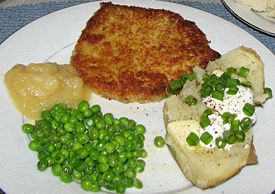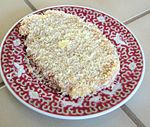Schnitzel: Difference between revisions
imported>Ro Thorpe m (→Origin legends) |
imported>Ro Thorpe m (→Ingredients and preparation: punct before ref) |
||
| Line 55: | Line 55: | ||
{{Image|escalope_uncooked.jpg|left|150px|A homemade schnitzel with its breading, waiting to be refrigerated, then cooked}} | {{Image|escalope_uncooked.jpg|left|150px|A homemade schnitzel with its breading, waiting to be refrigerated, then cooked}} | ||
Veal schnitzels are traditional but pork, chicken, and turkey are also frequently used<ref>Turkey cutlets from large pieces of the breast meat are big enough to resemble genuine veal cutlets and are sometimes substituted in restaurant cooking by unscrupulous cooks.</ref> | Veal schnitzels are traditional but pork, chicken, and turkey are also frequently used.<ref>Turkey cutlets from large pieces of the breast meat are big enough to resemble genuine veal cutlets and are sometimes substituted in restaurant cooking by unscrupulous cooks.</ref> The same technique is used as for veal. | ||
Schnitzels may also be prepared without the breading, when they are known as ''au naturel'' or ''au nature''.<ref name="isbn0-517-50663-7">{{cite book | Schnitzels may also be prepared without the breading, when they are known as ''au naturel'' or ''au nature''.<ref name="isbn0-517-50663-7">{{cite book | ||
Revision as of 11:36, 9 August 2010
A schnitzel is a thin slice of meat. The word is of German origin, and as in German-speaking countries, schnitzel is also used for dishes prepared with such a slice. If no preparation is mentioned then a schnitzel is a breaded or Wiener schnitzel, a schnitzel fried with a coating of egg and breadcrumbs (also called an escalope).
While the Wiener schnitzel of the international cuisine knows many variants — both of the meat used and the garnish accompanying it — its prototype — the Austrian speciality Wiener Schnitzel — has to be made with veal and should be accompanied by potatoes and a lemon wedge.
Preparation
A schnitzel is usually prepared from a thin cutlet of veal, although chicken or pork cutlets can be used instead of veal. Always cooked in butter or oil, the breaded cutlet is generally sautéed but occasionally is deep-fried in oil or fat. Many variations of the schnitzel developed as this well-known recipe spread throughout Europe.
Origin legends
The breaded schnitzel is a dish from Austria although variations of this dish are eaten throughout Europe including Germany, France, and Italy. Two frequently repeated legends claim to describe its origin:
- The first legend derives it from a 16th-century practice of serving meat covered in gold, or even traces it back to the Byzantine Empire, in particular to Basileios I (867–886 AD). According to this legend, the effort to imitate the golden appearance eventually lead to cutlets being cooked in bread crumbs. The bread crumbs were substituted to represent the gold leaf-covered meat as a cost-saving measure.[1][2] The practice of preparing meat wrapped in bread crumbs spread throughout Europe.
- Another unproven story claims that the schnitzel was discovered in Italy by Austrian Joseph Graf Radetzky in the 1800s. The dish Radetzky discovered was known as costoletta alla milanese and was made from a thick slice of veal, coated in bread crumbs, then sautéed in butter. Radetzky, who served as commander of the Austrian troops from 1831 to 1857, shared the recipe with the emperor of Austria as part of his duties to report military, political and culinary affairs in Italy. After Radetzky had shared the costoletta alla milanese recipe, Austrian cooks perfected the recipe by pounding veal until it was a finger-width thick, and dipped the cutlets in flour, egg and bread crumbs. The cutlets were cooked in hot fat until golden.[3][2]
Neither story has been confirmed by historians.
Ingredients and preparation
Veal schnitzels are traditional but pork, chicken, and turkey are also frequently used.[4] The same technique is used as for veal.
Schnitzels may also be prepared without the breading, when they are known as au naturel or au nature.[5][6] In this case, they are sometimes dusted with seasoned or plain flour before being cooked.
The Wiener schnitzel originated in Vienna and is always made from veal. This dish is often found at German restaurants.[1][2]
Variations in preparing schnitzels include cheese schnitzel where the veal cutlet is prepared as for Wiener schnitzel but is dipped in a half-and-half mixture of Parmesan cheese and bread crumbs. This dish is served with a lemon slice for garnish.
Almond schnitzels are veal dipped in sour cream and then almonds before cooking.[7][8][9]
Similar dishes
Veal cordon bleu, veal parmigiana, and many veal scallop dishes, including, for instance, escalope de veau Orloff, all use similar cooking techniques as schnitzel. Veal cordon bleu has veal cutlets stuffed with prosciutto or smoked ham with Swiss cheese. The filling is sandwiched between veal cutlets, breaded and cooked in butter. Veal parmigiana is prepared by breading the cutlets in Parmesan cheese and bread crumbs then sautéing the cutlets in clarified butter. The cutlets are then served with a tomato sauce. Veal scallop has veal cutlets sautéed in clarified butter a soubise mixture of cooked rice, onions and mushrooms are sandwiched between the veal cutlets. The cutlets are then covered with a small amount of liver paste, sprinkled with brandy or dry sherry and then receive a sprinkling of Parmesan cheese. They are then baked until the cheese is golden.[10]
An excellent recipe using veal or pork schnitzel is Jägerschnitzel, where Jäger means hunter. The cutlet, which may or may not be breaded, is topped with a burgundy-mushroom sauce.
References
- ↑ 1.0 1.1 German Food Guide - Schnitzel (i). Retrieved on 2010-08-08. Cite error: Invalid
<ref>tag; name "urlGerman Food Guide - Schnitzel" defined multiple times with different content - ↑ 2.0 2.1 2.2 GuteKueche — das Gourmet Portal (automatically translated from German). Retrieved on 2010-08-08. Cite error: Invalid
<ref>tag; name "urlGoogle Translate" defined multiple times with different content Cite error: Invalid<ref>tag; name "urlGoogle Translate" defined multiple times with different content - ↑ All About Wiener Schnitzel | The Hungarian Girl. Retrieved on 2010-08-08.
- ↑ Turkey cutlets from large pieces of the breast meat are big enough to resemble genuine veal cutlets and are sometimes substituted in restaurant cooking by unscrupulous cooks.
- ↑ Gary, Joy; Schuler, Elizabeth (1983). German cookery. New York: Crown Publishers. ISBN 0-517-50663-7.
- ↑ Wason, Betty (1967). German cookery. New York: Doubleday and Company. ISBN None.
- ↑ Sheraton, Mimi (1965). The German cookbook; a complete guide to mastering authentic German cooking. New York: Random House. ISBN 0-394-40138-7.
- ↑ Hanna, Elaine; Anderson, Jean Bradley (1985). The new Doubleday cookbook. Garden City, N.Y: Doubleday. ISBN 0-385-19577-X.
- ↑ Beard, James (1980). James Beard's American Cookery. Boston: Little, Brown. ISBN 0-316-08566-9.
- ↑ Becker, Marion Rombauer; Rombauer, Irma von Starkloff (1975). Joy of cooking. Indianapolis: Bobbs-Merrill. ISBN 0-02-604570-2.

